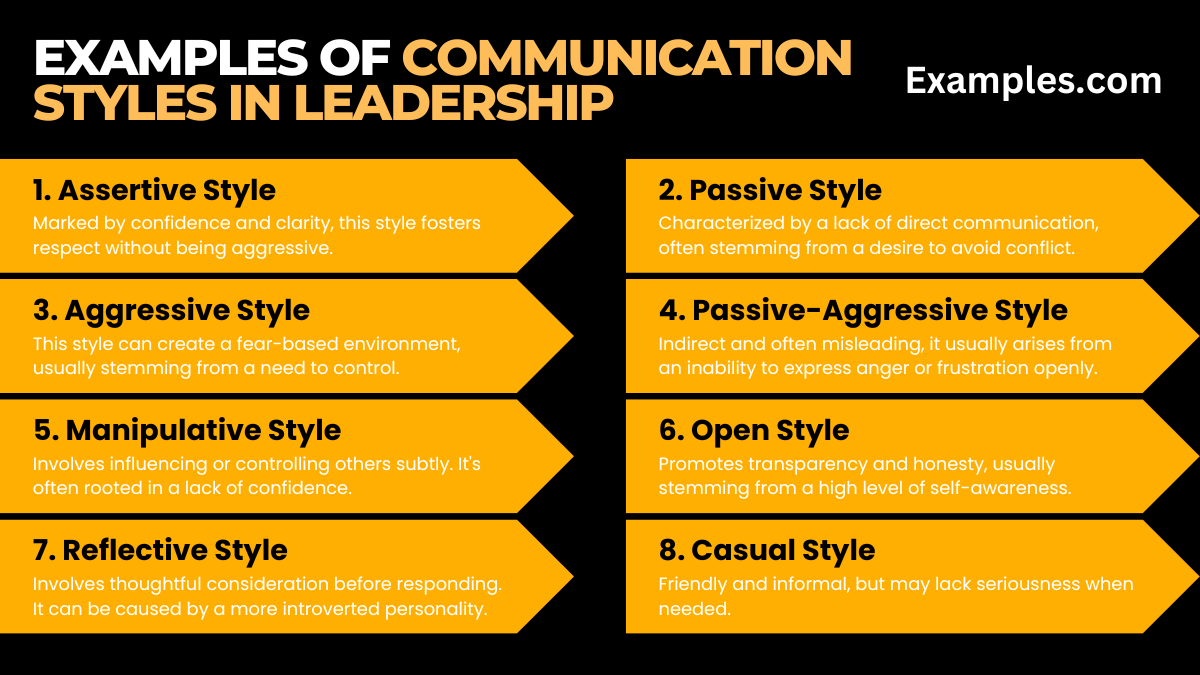9+ Communication Styles in Leadership
Leadership success hinges on effective communication, and understanding various communication styles in leadership is crucial. This comprehensive guide delves into the nuances of leadership communication, offering practical communication examples and insights. Whether you’re a seasoned leader or aspiring to be one, you’ll find valuable tips on how to enhance your communication skills. Explore different styles, learn from real-world examples, and discover how to apply these techniques to inspire, motivate, and lead your team effectively.
What’s Your Leadership Communication Style? – Meaning

Your leadership communication style is the essential manner in which you convey messages and interact with your team. This style goes beyond mere words; it includes your tone, body language, and non-verbal cues, impacting team dynamics, morale, and productivity. It’s a blend of your inherent traits and acquired leadership communication skills, shaping how you guide, motivate, and foster collaboration within your team. Understanding and refining your communication style is crucial for effective leadership, as it helps in creating an environment of clarity, trust, and cooperation. Recognizing whether your style aligns more with coaching, advising, or motivating can lead to more impactful and motivating communication styles that resonate with your team.
10 Examples of Communication Styles in Leadership
Leadership is greatly defined by communication styles, which vary from leader to leader. Each style has its unique impact on team dynamics and overall organizational culture. Understanding these styles helps in fostering better team communication and enhancing leadership effectiveness. This section provides a closer look at ten distinct communication styles in leadership. We’ll explore the causes behind each style, its effects on the workplace, and practical tips for improvement, ensuring a collaborative and motivating environment.

- Assertive Style: Marked by confidence and clarity, this style fosters respect without being aggressive. It’s often caused by high self-esteem and a clear vision. To improve, balance assertiveness with empathy.
- Passive Style: Characterized by a lack of direct communication, often stemming from a desire to avoid conflict. Improvement involves practicing assertiveness and clear articulation of thoughts.
- Aggressive Style: This style can create a fear-based environment, usually stemming from a need to control. Softening the approach and practicing active listening can mitigate its negative effects.
- Passive-Aggressive Style: Indirect and often misleading, it usually arises from an inability to express anger or frustration openly. Encouraging direct communication and feedback can be helpful.
- Manipulative Style: Involves influencing or controlling others subtly. It’s often rooted in a lack of confidence. Promoting transparency and direct communication helps counteract this style.
- Open Style: Promotes transparency and honesty, usually stemming from a high level of self-awareness. Continual feedback and active listening help maintain its effectiveness.
- Reflective Style: Involves thoughtful consideration before responding. It can be caused by a more introverted personality. Encouraging timely decision-making can enhance this style’s effectiveness.
- Casual Style: Friendly and informal, but may lack seriousness when needed. Balancing informality with formality, especially in serious situations, can improve this style.
- Directive Style: Involves clear instructions and close supervision. Often results from a need for control or urgency. Balancing direction with empowerment can make this style more effective.
- Inspirational Style: Motivates and inspires action, but may lack detail orientation. Balancing inspiration with actionable steps can enhance its impact.
Communication Styles in Nursing Leadership
Nursing leadership requires a unique blend of empathy and assertiveness. Effective communication in management within nursing is pivotal for patient care and team coordination. This segment explores various communication styles prevalent in nursing leadership. Each style significantly influences patient outcomes and team morale, and understanding these can lead to improved healthcare delivery.
- Empathetic Engagement: Nurses lead with understanding and compassion.
Example: “I hear your concerns and we’ll address them together.” - Instructional: Direct and clear, ideal for fast-paced situations.
Example: “Please administer this medication now.” - Collaborative: Encourages team input for decision-making.
Example: “Let’s discuss the best approach for patient care.” - Supportive: Offers encouragement and reassurance.
Example: “You’re doing a great job; keep going.” - Delegative: Assigns tasks while overseeing overall care.
Example: “I need you to monitor these patients; I’ll oversee the process.” - Authoritative: Makes decisive choices for patient welfare.
Example: “We need to act now to stabilize the patient.” - Consultative: Seeks advice from specialists when needed.
Example: “Let’s consult with the oncologist for this case.” - Visionary: Inspires the team towards future goals.
Example: “Together, we can improve patient care significantly.” - Transactional: Focuses on tasks and results.
Example: “Complete these tasks by the end of your shift.” - Transformational: Motivates and transforms the healthcare environment.
Example: “Let’s innovate our approach to patient care.”
Communication Styles in Education Leadership
Effective communication in education leadership shapes learning environments and academic success. This section highlights key communication styles used by educational leaders, demonstrating their influence on teachers and students alike. Mastery of these styles can lead to a more engaging and productive educational setting.
- Directive: Provides clear, concise instructions.
Example: “Please follow the curriculum guidelines closely.” - Inclusive: Encourages participation from all staff members.
Example: “I value everyone’s input on this issue.” - Visionary: Shares a long-term educational vision.
Example: “Our goal is to develop lifelong learners.” - Empowering: Builds confidence and independence in staff.
Example: “I trust your judgment in handling this class.” - Mentoring: Offers guidance and support to new teachers.
Example: “Let me share some strategies that might help.” - Analytical: Uses data to inform decisions.
Example: “Based on these test scores, we need to adjust our approach.” - Democratic: Seeks consensus for major decisions.
Example: “Let’s vote on the proposed changes.” - Coaching: Provides feedback for continuous improvement.
Example: “Here’s how you can enhance your teaching method.” - Facilitative: Focuses on enabling teachers to find solutions.
Example: “Explore different teaching styles to see what works best.” - Adaptive: Adjusts communication based on the situation.
- Example: “For this particular challenge, let’s try a different approach.”
Communication Styles in Business Leadership
In the realm of business leadership, communication styles significantly impact organizational culture, employee engagement, and business outcomes. This section outlines various communication styles prevalent in the business sector, each contributing to the dynamics of corporate management and decision-making processes.
- Strategic: Focuses on long-term business goals.
Example: “Our strategy should align with market trends.” - Inspirational: Motivates teams towards achieving objectives.
Example: “We have the potential to lead our market.” - Negotiative: Utilizes discussion and compromise.
Example: “Let’s find a middle ground that benefits both parties.” - Analytical: Relies on data and facts for decisions.
Example: “The data shows we should target this demographic.” - Charismatic: Uses personal appeal to inspire.
Example: “Your dedication is the key to our success.” - Participative: Encourages team involvement in decision-making.
Example: “I want to hear your ideas on this project.” - Transactional: Focuses on performance and results.
Example: “Meet these targets to achieve the bonus.” - Transformational: Drives change and innovation.
Example: “Let’s revolutionize our approach to customer service.” - Situational: Adapts style based on the circumstance.
Example: “This situation calls for a more hands-on approach.” - Consultative: Seeks input before making decisions.
Example: “Your feedback is crucial for our next move.”
Different Communication Styles in Leadership
In leadership, effective communication is a linchpin for success. Understanding different communication styles in leadership is crucial for managing teams, driving change, and achieving organizational goals. Each style has its unique impact and applicability depending on the context and team dynamics.
- Visionary Style: This style is future-oriented, inspiring teams towards a shared goal. It’s effective for motivating during times of change but might lack detailed guidance.
- Coaching Style: Focuses on personal development of team members. Ideal for building long-term capabilities, though it may not be suitable in urgent scenarios.
- Affiliative Style: Prioritizes creating emotional bonds and harmony, great for building team cohesion, but may avoid necessary confrontational discussions.
- Democratic Style: Seeks consensus and values team inputs. It fosters a participative environment but can lead to delays in decision-making.
- Pacesetting Style: Sets high standards for performance. Effective for quick results but may overwhelm team members if overused.
What are the types of Leadership Communication Styles?
Identifying types of leadership communication styles can greatly enhance a leader’s ability to manage effectively. Each style has its strengths and is suited to different situations and team compositions.
- Directive Style: Characterized by giving clear, authoritative instructions. It’s efficient in crisis situations but can stifle creativity and autonomy.
- Analytical Style: Relies on data and logic to communicate. It ensures informed decisions but might overlook emotional aspects of team management.
- Inspirational Style: Motivates and encourages team members towards achieving a vision. Ideal for boosting morale, though it requires a balance with practical guidance.
- Consultative Style: Involves seeking input and advice before making decisions. This inclusive approach builds trust but might not be practical in time-sensitive situations.
What’s Your Leadership Communication Style?
Identifying your leadership communication style is essential for effective team management. It influences how you interact with your team, make decisions, and resolve conflicts.
- Self-Assessment: Reflect on your interactions and feedback to understand your default communication style.
- Contextual Adaptation: Be prepared to adapt your style to suit different situations and team needs.
- Continuous Learning: Seek opportunities for development through training, mentorship, and feedback to refine your communication skills.
Understanding and applying various communication styles in leadership is crucial for effective team management and organizational success. Each style offers unique benefits and challenges. Leaders who adapt their communication to suit their team’s needs and situations can inspire, motivate, and lead more effectively, thereby enhancing team dynamics, fostering collaboration, and achieving desired outcomes.



